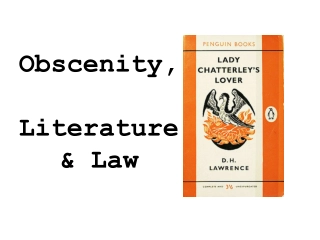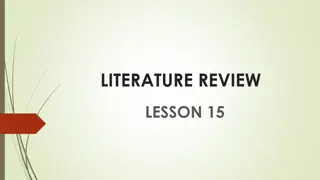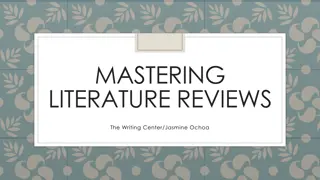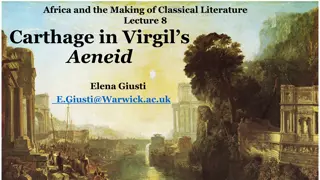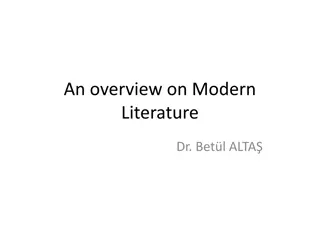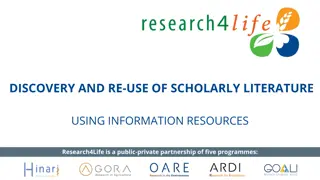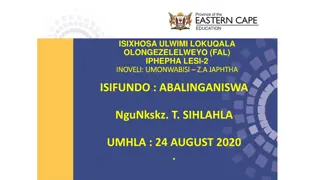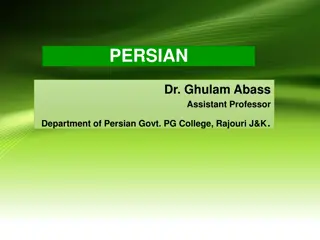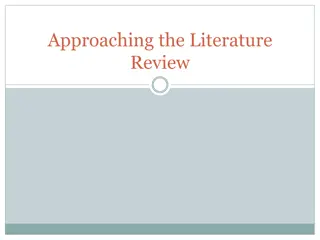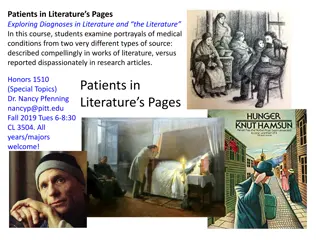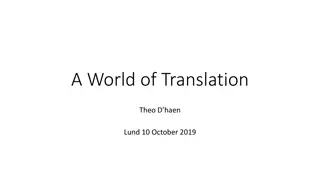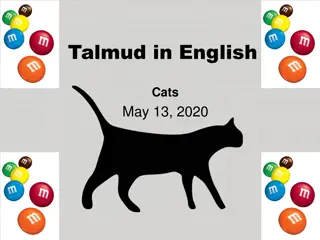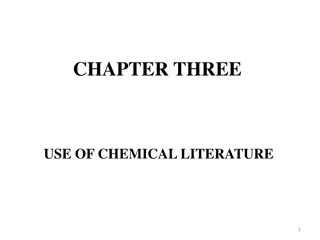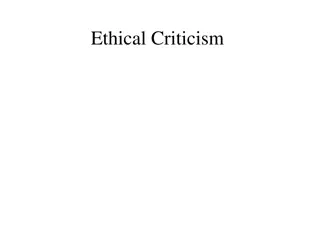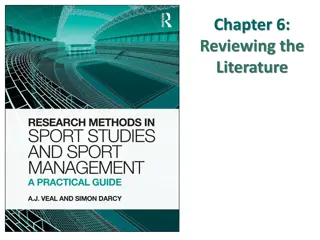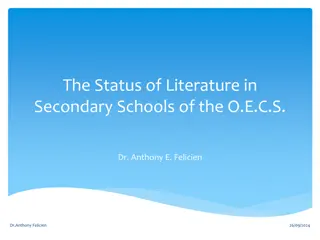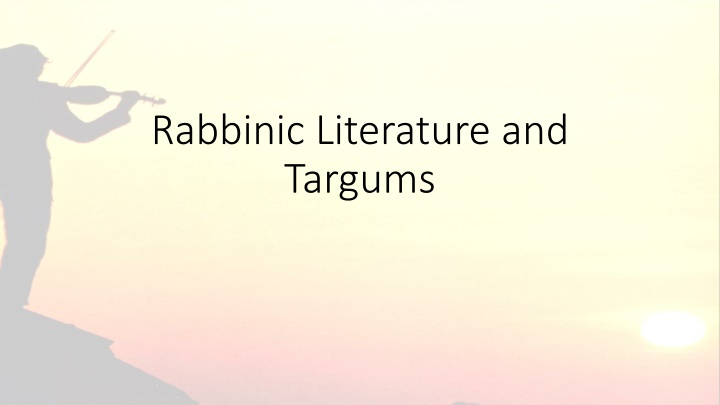
Rabbinic Literature and Targums
Explore the essence of Rabbinic Literature and Targums, including their historical significance, hermeneutics, and influence on biblical studies. Delve into the introduction of Rabbinic Judaism, the definition of Rabbinic Literature, and comparisons with early Christian literature. Uncover the contents of Talmudic and Midrashic literature for a comprehensive understanding of these texts.
Download Presentation

Please find below an Image/Link to download the presentation.
The content on the website is provided AS IS for your information and personal use only. It may not be sold, licensed, or shared on other websites without obtaining consent from the author. If you encounter any issues during the download, it is possible that the publisher has removed the file from their server.
You are allowed to download the files provided on this website for personal or commercial use, subject to the condition that they are used lawfully. All files are the property of their respective owners.
The content on the website is provided AS IS for your information and personal use only. It may not be sold, licensed, or shared on other websites without obtaining consent from the author.
E N D
Presentation Transcript
Rabbinic Literature and Targums
Basic Outline: Basic Outline: Part 1: Rabbinic Literature Introduction Historical Location Rabbinic Hermeneutics The literature Their Use in Biblical Studies
Rabbinic Literature: Introduction Rabbinic Literature: Introduction Definition of Rabbinic Judaism: the Judaism of the dual Torah. (Jacob Neusner) Definition of Rabbinic Literature: the corpus of writing produced in the first seven centuries C.E. by sages who claimed to stand in the chain of tradition from Sinai and uniquely to possess the oral part of the Torah, revealed by God to Moses at Sinai for oral formulation and oral transmission, in addition to the written part of the Torah possessed by all Israel (Neusner).
Rabbinic Literature: Introduction Rabbinic Literature: Introduction What if Early Christian Literature was like Rabbinic Literature? 1. Not only the New Testament, but all the works of the church fathers, from Justin to Augustine, now would be represented as expressions of one communal mind, dismembered and built into a single harmonious logical structure on various themes. 2. . . . this would be not merely a matter of early Christian literature s reaching us without the names of the authors of its individual documents. The thing we must try to imagine is that there would be no individual documents at all.
Rabbinic Literature: Introduction Rabbinic Literature: Introduction What if Early Christian Literature was like Rabbinic Literature? 3. what should we know about Jesus, and how should we know it, if sayings assigned to Jesus in one book were given to Paul in a second, to John in a third, and to They said or He said to them in a fourth? . . . Rabbinic literature . . . document by document presents us with rabbinic Judaism in homogenized, seamless form. (Neusner)
Rabbinic Literature: Introduction Rabbinic Literature: Introduction Contents: Talmudic Literature includes predominantly legal works which are topically/thematically arranged: Mishna Tosefta Jerusalem Talmud Babylonian Talmud Minor Tractates
Rabbinic Literature: Introduction Rabbinic Literature: Introduction Contents: Midrashim are various exegetical works arranged according to scripture (like a commentary): Tannaitic Midrashim Amoraic Midrashim Later Midrashim and Medieval Commentators
Rabbinic Literature: Historical Location Rabbinic Literature: Historical Location Jacob Neusner s Four Judaic Systems: The age of diversity (586 BC AD 70) The formative age of Judaism (AD 70-640) The classical period of Judaism (AD 640-1787) The modern age the second age of diversity (AD 1787-present) Time period of Rabbinic Literature: ca. AD 70 ca. 1040
Rabbinic Literature: Historical Rabbinic Literature: Historical Location Location Rabbinic Judaism as a descendent of Pharisaic Judaism: Josephus describes the Pharisees as follows: The hallmark of Pharisaism was belief in the twofold Torah. . . They were esteemed by the majority of Jews as the most accurate interpreters of the laws. . .
Rabbinic Literature: Historical Rabbinic Literature: Historical Location Location Rabbinic Judaism as a descendent of Pharisaic Judaism: Josephus describes the Pharisees as follows: They held to both providence and free will. They believed in the immortality of the soul and the bodily resurrection of the righteous. They practiced a civil and polite manner of interaction with themselves and others and lived as simply as possible.
Rabbinic Literature: Historical Rabbinic Literature: Historical Location Location Rabbinic Judaism as a descendent of Pharisaic Judaism: For Pharisaism, the priests alone could no longer be responsible for the holiness of Israel; rather, every household stands under this obligation through which it may contribute to Israel s standing before God. (Deines, Pharisees, 1062)
Rabbinic Literature: Historical Rabbinic Literature: Historical Location Location Early Rabbinic Judaism Reorganization after the destruction of the Temple in AD 70. Growing consolidation under the Rabbis after AD 135. Growing influence of the Rabbis among the Jews and growing influence of Christianity in the Roman Empire in the third century. Growth of the Rabbinic Judaism in Babylon, and later, Egypt, North Africa and Spain.
Rabbinic Literature: Historical Rabbinic Literature: Historical Location Location The traditional divisions of Rabbinic history: The Tannaitic period (approximately 50 BC to AD 200): five generations The Amoraic period (AD 220 to AD 500): seven generations The Saboraic period (AD 500 to AD 650) The Geonic period (AD 650 to AD 1050)
Rabbinic Literature: Historical Rabbinic Literature: Historical Location Location Most Important/Noteworthy Rabbis: The Earliest Period The chain of rabbis that go back to the great men of the Synagogue. Hillel Shammai
Rabbinic Literature: Historical Rabbinic Literature: Historical Location Location Most Important/Noteworthy Rabbis: First Generation Tannaites School of Shammai and school of Hillel: In the controversies, about two- thirds of which deal either directly or indirectly with the food laws, the school of Shammai usually decides more severely (exceptions in Eduy 4-5); that of Hillel, more leniently. . . At Yabneh, the Hillelite faction tended to prevail; this in turn also influenced the formation of the tradition. Rabban Gamaliel I, the elder. Gamaliel was the teacher of the Apostle Paul and a member of the Sanhedrin (Acts 22:3; cf. 5:34-39). Rabban Yohanan ben Zakkai: When Jerusalem was under seige by the Romans in AD 70, he fled Jerusalem and began an academy at Yabneh (Jamnia) which was the beginning of rabbinic Judaism.
Rabbinic Literature: Historical Rabbinic Literature: Historical Location Location Most Important/Noteworthy Rabbis: Second Generation of Tannaites (c. 90-130): R. Ishmael ben Elisha (R. Ishmael). R. Aqiba ben Joseph (R. Aqiba). Aqilas, the Proselyte.
Rabbinic Literature: Historical Rabbinic Literature: Historical Location Location Most Important/Noteworthy Rabbis: Third Generation of Tannaites (c. 130-160): Ishmael s Students: the students of Ishmael are less frequently mentioned in the Mishnah The Students of Aqiba: R. Meir was a student of Ishmael, then Aqiba. He was significant in the redaction of the Mishnah. Sanh 86a attributes the anonymous part of the Tosefta to R. Nehmyah.
Rabbinic Literature: Historical Rabbinic Literature: Historical Location Location Most Important/Noteworthy Rabbis: Fourth generation of Tannaites: Symmachos (ben Joesph). R. Yehudah ha-Nasi (d. 217): The prince, or Patriarch, he is often simply called Rabbi. Most Important/Noteworthy Rabbis: Fifth Generation of Tannaites: R. Hiyya. He may have been the redactor of the Tosefta. Most Important/Noteworthy Rabbis: First Generation of Amoraim: Abba Arikha, the Tall. A Babylonian Amoraim, he is usually called Rab.
Rabbinic Literature: Historical Rabbinic Literature: Historical Location Location Most Important/Noteworthy Rabbis: Second Generation of Amoraim: Yohanan bar Nappaha. Most Important/Noteworthy Rabbis: Sixth Generation of Amoraim in Babylonia: Rab (or Rabbana) Ashi.
Rabbinic Literature: Rabbinic Hermeneutics Rabbinic Literature: Rabbinic Hermeneutics Biblical Interpretation in the Second Temple Period: Characterized by both very close reading and great exegetical freedom. (Kugel) Four basic assumptions in All Second Temple interpretation: scriptural texts were basically cryptic. . . although most of Scripture had been written hundreds of years earlier and seemed to be addressed to people back then, its words nevertheless were altogether relevant to people in the interpreters own day . . . Scripture was altogether harmonious in all its details and altogether true . . . all of Scripture was of divine origin. . .
Rabbinic Literature: Rabbinic Hermeneutics Rabbinic Literature: Rabbinic Hermeneutics Rabbinic Interpretation: Midrash Refers to either 1. Scriptural interpretation, or 2. Collections of Rabbinic Exegesis Concerned with the words of Scripture Characterized by creative historiography and creative philology Aimed at 1. resolving difficulties and 2. applying the Scripture to life Two kinds: Halakic (legal) and Haggadic (non-legal, religious and moral)
Rabbinic Literature: Rabbinic Hermeneutics Rabbinic Literature: Rabbinic Hermeneutics Rabbinic Interpretation: Peshat literalistic interpretation. Later distinguished from Midrash Rabbinic Interpretation: Pesher Two presuppositions: 1. The biblical author wrote about the last days; 2. The interpreter is living in those days No Pesher in Rabbinic interpretation: The theological presumptions of pesher exegesis were not in agreement with rabbinic notions of prophecy, and the rabbis tended in general to minimize apocalyptic trends. (Schiffman, Early Judaism and Rabbinic Judaism, 286.)
Rabbinic Literature: Rabbinic Hermeneutics Rabbinic Literature: Rabbinic Hermeneutics Rabbinic Interpretation: The Seven Rules of Hillel Qal wa-homer: from the lighter to the heavier Gezerah shawah: lit, equal ordinance or statute. An argument from analogy. Binyan ab mi-katub ehad, lit.: founding of a family from a single Scripture text. Binyan ab mi-shn ketubim: two passages produce the principle. Kelal u-ferat u-ferat u-kelal: The general and the particular, the particular and the general. Ke-yose bo be-maqom aher: something similar to this in another passage. Dabar ha-lamed me- inyano: the argument from the context.
Rabbinic Literature: Rabbinic Hermeneutics Rabbinic Literature: Rabbinic Hermeneutics Rabbinic Interpretation: The Thirteen Middot of R. Ishmael Ishmael s 1-2 = Hillel s 1-2 Ishmael s 3 = Hillel s 3-4 Ishmael s 4-11 = Hillel s 5 Ishmael s 12 = Hillel s 7 Hillel s 6 is ommitted Ishmael s #13 is new: Two verses of Scripture contradict each other until the third verse comes and decides between them.
Rabbinic Literature: Rabbinic Hermeneutics Rabbinic Literature: Rabbinic Hermeneutics Rabbinic Interpretation: The Thirty-Two Middot Many of these demonstrate the creative philology or close attention to the text with great exegetical freedom For example, # 10: Repetition is used for interpretation. The repeated number of mention of the cows and ears of corn in Pharaoh s dream means that it was supposed to be14, 28, or 42 years. #11: Related material which is separated (by sof pasuq or another disjunctive accent). Ignoring the verse divisions to relate what are apparently unrelated words or phrases.
Rabbinic Literature: Rabbinic Hermeneutics Rabbinic Literature: Rabbinic Hermeneutics Rabbinic Interpretation: The Thirty-Two Middot Some demonstrate thoughtful attention to the text For example, #18: One particular instance is mentioned in a category of events, although the whole category is intended. . . . on Deut 20.5f.: whoever has built a new house but has not yet dedicated it, may withdraw from armed service. Only building is mentioned here, but it applies as well to inheriting, buying, and receiving as a gift. (Strack and Stemberger, Talmud and Midrash, 27)
Rabbinic Literature Rabbinic Literature: : Talmudic Literature: Mishna Tosefta Jerusalem Talmud Babylonian Talmud Minor Tractates Midrash: Tannaic Midrash Amoraic Midrash Later Midrash and Commentary
Talmudic Literature: The Mishnah Talmudic Literature: The Mishnah Definition: The Hebrew shanah means to repeat, or in a technical sense means to learn or to teach. Mishnah designates the entire religious law formulated until c. 200, but also the teachings of a teacher (Tannaite) active in this period as well as an individual proposition (= halakhah) or collections of such propositions. . . . The Mishnah par excellence is the collection attributed to R. Yehudah ha- Nasi, with which we are here concerned. (Strack and Stemberger, Talmud and Midrash, 109) Mishnah designates: 1. individual teachings, 2. the teachings of a Tannaite, 3. All the law formulated until ca. 200 AD, and 4. especially the collection attributed to Rabbi ( the Prince ).
Talmudic Literature: The Mishnah Talmudic Literature: The Mishnah Structure and Contents: The Mishnah (M) has six orders (sederim). Each order is made up of several tractates called massekhet ( fabric ) or massekhta (in Aramaic). The tractates are divided into chapters (pereq) The chapters are divided into sentences (mishnah or halakhah in the PT).
Talmudic Literature: The Mishnah Talmudic Literature: The Mishnah The Structuring Principle: Thematically arranged Association by topic or speaker Exegesis of books Thus the composition of materials in M, which to the modem reader seems unsystematic, is due to various structuring principles in use at the time. (Strack and Stemberger, Talmud and Midrash, 123)
Talmudic Literature: The Mishnah Talmudic Literature: The Mishnah Structure and Contents: First Order: Zera im, Seeds Second Order: Mo ed, Festival Days Third Order: Nashim, Women Fourth Order: Neziqin, Damages Fifth Order: Qodashim, Holy Things Sixth Order: Toharot, Purities
Talmudic Literature: The Mishnah Talmudic Literature: The Mishnah First Order: Zera im, Seeds Berakhot ( blessings ): laws regarding prayer and blessings. Peah ( corner, as in, the corner of the field left for the poor): laws regarding giving to the poor. Demai ( doubtful ): regarding fruits of which the tithe laws may be unclear. Kilaim ( different kinds ): laws about illicit mixtures of things. Shebi it (the seventh year ): laws regarding the sabbath year. Terumoth ( heave offerings ): laws regarding the offerings given to priests (Num 18:8ff, 18:25ff; Deut 18:4).
Talmudic Literature: The Mishnah Talmudic Literature: The Mishnah First Order: Zera im, Seeds Ma aserot or Ma aser Rishon ( tithe or first tithe ): laws of tithes given to Levites (Num 18:21ff). Ma aser Sheni (the second tithe, Deut 14:22ff). Hallah ( dough offerings ): laws regarding the grain offering (Num 15:8ff). Orlah ( foreskin of trees): Laws regarding the fruit of trees which are considered uncircumcised for the first three years (Lev 19:23). Bikkurim ( firstfruits, Ex 23:19; Deut 26:1ff).
Talmudic Literature: The Mishnah Talmudic Literature: The Mishnah Second Order: Mo ed, Festival Days Shabbat: laws regarding Sabbath. The few Pentateuchal Sabbath regulations are here developed in great deal . . . Thirty-nine major kinds of forbidden tasks. (Ex 20:10; 23:12; Deut 5:14, etc.). Erubin ( mixtures ): ways of bypassing certain Sabbath laws. Pesahim ( passover ) Sheqalim ( sheqels ): laws regarding the half-shekel tax used for the temple services at the Second Temple. Yoma ( the day ): laws regarding the Day of Atonement. Sukkah ( booth, plural Sukkot): laws regarding the feast of booths.
Talmudic Literature: The Mishnah Talmudic Literature: The Mishnah Second Order: Mo ed, Festival Days Besah ( egg, the first word of the tractate; also called Yom Tob, holy day ): laws regarding the holy days. Rosh ha-Shanah ( new year s festival ) Ta anit (or Ta aniyot, fasting ) Megillah ( scroll ): laws regarding the liturgical reading of Torah. Mo ed Qatan ( lesser holy days, also called mashqin, or one waters, after the first word in the tractate): laws regarding labors allowed during the middle days of Passover and Sukkot. Hagigah ( celebration of a festival ): laws regarding the pilgrim festivals and purity laws including hand washing.
Talmudic Literature: The Mishnah Talmudic Literature: The Mishnah Third Order: Nashim, Women Yebamot ( sisters-in-law ): laws regarding levarite marriage and other issues. Ketubboth ( marriage contracts ): various laws regarding marriage. Nedarim ( vows and their cancellation) Nazir (the Nazarite vow)
Talmudic Literature: The Mishnah Talmudic Literature: The Mishnah Third Order: Nashim, Women Sotah ( the suspected adulteress ): regarding the water of jealousy and other issues (Num 5:11-31). Gittin ( divorce cirtificates ) Qiddushin ( betrothal, engagement )
Talmudic Literature: The Mishnah Talmudic Literature: The Mishnah Fourth Order: Neziqin, Damages Baba Qamma ( first gate of the tractate Neziqin, which was originally undivided): damages in the narrow sense: theft, bodily harm, etc. Baba Mesia ( middle gate ): laws regarding property, etc. Baba Bathra ( last gate ): more laws on property. Sanhedrin ( lawcourt ) Makkot ( stripes ): laws regarding corporal punishment. Shebuot ( oaths )
Talmudic Literature: The Mishnah Talmudic Literature: The Mishnah Fourth Order: Neziqin, Damages Eduyot ( testimonies ): statements of later teachers regarding the sayings of earlier masters. Abodah Zarah ( idolatry ) Abot ( [sayings of the] Fathers, also called Pirqe Abot, sections, chapters of the Fathers ): sayings of the fathers. Horayot ( instructions, decisions ): misc. laws, including discussions of erroneous judgments.
Talmudic Literature: The Mishnah Talmudic Literature: The Mishnah Fifth Order: Qodashim, Holy Things Zebahim ( sacrificial victims ): various laws regarding sacrifice. Menahoth ( meal offerings ): various laws regarding the grain offerings. Hullin (profane things ): laws regarding clean vs unclean animals, how and by whom they are to be slaughtered. Bekhorot ( first-born ): laws regarding first-born animals and people, among other things. Arakhin ( assessments ): sums paid for vows, etc. Temurah ( exchange of sacrificial animals)
Talmudic Literature: The Mishnah Talmudic Literature: The Mishnah Fifth Order: Qodashim, Holy Things Keritot ( extirpations ): extirpation is interpreted as dying of natural causes, without natural descendents, between ages 20-50. There are 36 intentional sins that might result in extirpation. Me ilah ( embezzlement ): use and abuse of consecrated things. Tamid (from olat tamid, daily burnt offering ): various laws dealing with the priestly tasks. Middot (temple measures and furnishings): the furnishings and services at the temple. Qinnim ( bird s nests ): various laws regarding birds as offerings.
Talmudic Literature: The Mishnah Talmudic Literature: The Mishnah Sixth Order: Toharot, Purities Kelim ( utensils ): laws regarding various kinds of vessels and impurities. Ohalot ( tents, or Ahilot, tent coverings ): dealing with impurities spread by a dead body. Nega im ( plagues ): skin diseases and leprosy. Parah ( [red] heifer ) Toharot ( purities, a euphemism for impurities ): laws regarding defilement. Miqva ot ( immersion pools ): dimensions of immersion pools, how they are to be used, and when ineffectual.
Talmudic Literature: The Mishnah Talmudic Literature: The Mishnah Sixth Order: Toharot, Purities Middah ( [menstrual] uncleanness ) Makhshirin ( what predisposes [to defilement] ): liquids that make dry foods predisposed to defilement. Zabim ( those with unclean emission ) Tebul Yom ( one who has taken a ritual bath on the same day ) Yadayim ( hands ): impurity and purification of hands. Debates around canonical books. The difference between the Pharisees and Sadducees (4:6-7). Uqsin ( stalks ): how stalks, peels, and kernels transmit impurity to the fruit, and vice versa.
Talmudic Literature: The Mishnah Talmudic Literature: The Mishnah Date: around AD 200, with some editing possibly continuing for around 50 years after Origin Traditional: Rabbi Yehudah ha-Nasi edited M; his main source was the Mishnah of R. Meir, who in turn is based on the Mishnah of his teacher Aqiba. Yet even Aqiba was not the Mishnah s first redactor, but resorted to a first Mishnah whose roots go back to biblical times. (Strack and Stemberger, Talmud and Midrash, 125). Thus: Oral tradition R. Aqiba R. Meir Rabbi
Talmudic Literature: The Mishnah Talmudic Literature: The Mishnah Relationship between Mishnah and Scripture: Two Views: 1. Mishnah is independent from Scripture as Oral Torah that originated with Moses 2. Mishnah is the consistent exegesis of Scripture
Talmudic Literature: The Talmudic Literature: The Tosefta Tosefta Definition The Tosefta (T) is names after the Aramaic word for addition or supplement. It is a halakhic work which corresponds in structure to M: the same six orders (sedarim) also comprise the same tractates [with some variance in arrangement] . . . Only the tractates Abot, Tamid, Middot and Qinnim have no equivalent to . . . is about four times as extensive as M. (Strack and Stemberger, Talmud and Midrash, 150)
Talmudic Literature: The Talmudic Literature: The Tosefta Tosefta Date: late 3rdor early 4thcentury Origin: Strack and Stemberger summarize the traditional view as follows: There was a of Nehemyah supplementing the M of Aqiba or Meir, which R. Hiyya then revised and completed in dependence on Rabbi s M. The purpose of according to this traditional perspective is the augmentation of M (lest the Tannaitic material omitted from M be forgotten), or a commentary on M. (Strack and Stemberger, Talmud and Midrash 152)
Talmudic Literature: The Talmudic Literature: The Tosefta Tosefta Relationship between Tosefta and Mishnah: Traditionally: Tosefta consists of traditional teachings that were left out of the Mishnah. They were collected so that they would not be lost. Strack and Stemberger: the relationship between the two needs to be judged on a case by case basis. Relationship between Tosefta and Talmuds: Debated. The Talmuds almost never quote it.
The Palestinian Talmud The Palestinian Talmud Definition Gemara is the commentary on the Mishnah. Mishnah + Gemara = Talmud Talmud means learning, study, or instruction. It refers to the teaching derived from the interpretation of M, which is contrasted with Scripture and M. (Strack and Stemberger, Talmud and Midrash, 164-166.)
The Palestinian Talmud The Palestinian Talmud Definition The Palestinian Talmud (PT) has been called the Talmud of the Land of Israel, Gemara of the Land of Israel, Talmud of the West, and Jerusalem Talmud. PT is the M commentary of the Palestinian Amoraim. It also includes additional material only loosely connected with M. (Strack and Stemberger, Talmud and Midrash, 164-166.) Contents: 39 out of 63 tractates of M (about the first four orders)


![[PDF⚡READ❤ONLINE] In Ruins: A Journey Through History, Art, and Literature](/thumb/20543/pdf-read-online-in-ruins-a-journey-through-history-art-and-literature.jpg)
